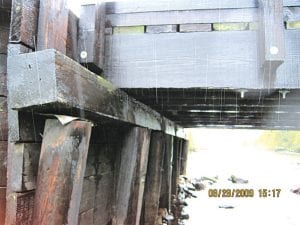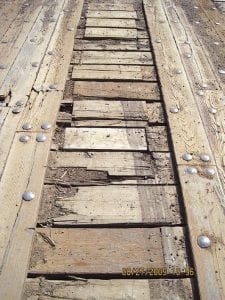The county board voted Tuesday, September 15, 2009 to pay Erickson Engineering Company of Bloomington up to $3,300 to inspect the Pine River bridge (between McFarland and Little John lakes) at the end of the Arrowhead Trail in Hovland. According to County Engineer Shae Kosmalski, a certified bridge inspector herself, the bridge is in “below average condition,” and she thinks it will probably need to be replaced next year.
Both the National Highway Institute and the Minnesota Department of Transportation require all bridges to be inspected each year except for a few that are in exceptionally good condition.
Last year, county engineering technician and certified bridge inspector Dick Christiansen gave the Pine River bridge a rating of four on a scale of 1-9, with a rating of one meaning a bridge would be closed. He recommended no restrictions at that point, but between then and now, Kosmalski said, the bridge has gone from “marginal to bad.” Kosmalski inspected the bridge recently and gave it a three-ton limit, which is about the weight of an ordinary pickup truck.
The bridge’s vertical timber pilings are molding and starting to rot, Kosmalski said. Theway the planks on top are fastened to the stringers underneath have caused them to be “subject to a lot more force than they should have been,” she said. She indicated she is afraid a car tire would be damaged by or even pop through one of the short planks between the ones that traverse the entire bridge from one side to the other.
The average life span of a bridge is 50 years, Kosmalski said, and this one is 50 years old. For now, plywood has been attached to the deck until a decision is made on what to do with the bridge.
If Kosmalski is a certified bridge inspector, why would the county need to spend money for a consulting company to do the same thing? Like the consultants, Kosmalski has passed a two-week bridge certification course, spent five years working under certified bridge inspectors, and takes refresher courses as required. Erickson Engineering, however, exclusively inspects bridges, Kosmalski said, and they specialize in timber bridges. They also have computer programs that can accurately determine load limits.
The company might agree with Kosmalski that a threeton limit is appropriate and recommend that the bridge be replaced next construction season. They might offer the option of repairs that could extend the life of the current bridge.
Commissioner Bob Fenwick asked Kosmalski why an analysis was needed now if the bridge would be replaced next year. Theyneed to know if emergency vehicles and fuel trucks can cross over the bridge this year, Kosmalski said. “When timber gets to a certain below average stage, it can then go downhill at a fast rate,” she said in a separate interview to explain why the bridge could pass a local inspection last year and need a consultant’s inspection this year.
Knowing that people would be concerned about getting needed deliveries, Kosmalski arranged for Erickson Engineering to come up before the end of the month. They may determine that even if the load limit needs to stay at three tons, an occasional overload might be safe enough to allow.
The average number of vehicles crossing the Pine River bridge is 45 per day.
Kosmalski will investigate the possibility of accessing Firewise funds for repairs to the bridge. She will also be inspecting other Cook County bridges this fall. “I don’t want anyone to get hurt,” she said.
”
Kosmalski gave the county board some information on state funding for future work on 18 bridges and 91 miles of unorganized township roads. To qualify for the funding, a total levy of about $4,300 per year would be required, but it could bring in over $100,000 a year for township road and bridge improvements, according to Kosmalski.
In other Highway Department news: As the county engineer is gathering a committee to work with the Arrowhead Regional Development Council (ARDC) on developing a priority list for potential nonmotorized paths along county roads, a couple of groups not on the ARDC’s recommended list of committee members have asked to be part of the conversation.
On the recommended list were representatives of county, city, tribal and township government, Cook County schools, the Minnesota Department of Natural Resources, the Minnesota Department of Transportation, the Gunflint Trail Association, the Cook County Local Energy Project, and the Cook County Economic Development Authority.
Both the Cook County ATV Club and the Arrowhead Coalition for Multiple Use wrote letters and appeared before the county board September 15 asking to have representatives appointed to the committee.
Vilnis Neilands of the ATV Club said he hoped ditches for ATVs could be improved at the same time any non-motorized trails went in. Chuck Silence of the Arrowhead Coalition for Multiple Use said, “We’re just asking to be involved.”
At the request of the county board, Kosmalski agreed to talk to Bryan Anderson of ARDC about adding the groups to the committee. Commissioner Bruce Martinson also recommended adding representation from the Gitchi-Gami Trail Association.
“Let’s make sure we have all the user groups on board….” said Commissioner Jim Johnson.
The initiative is being funded by a grant from the ARDC.




Loading Comments